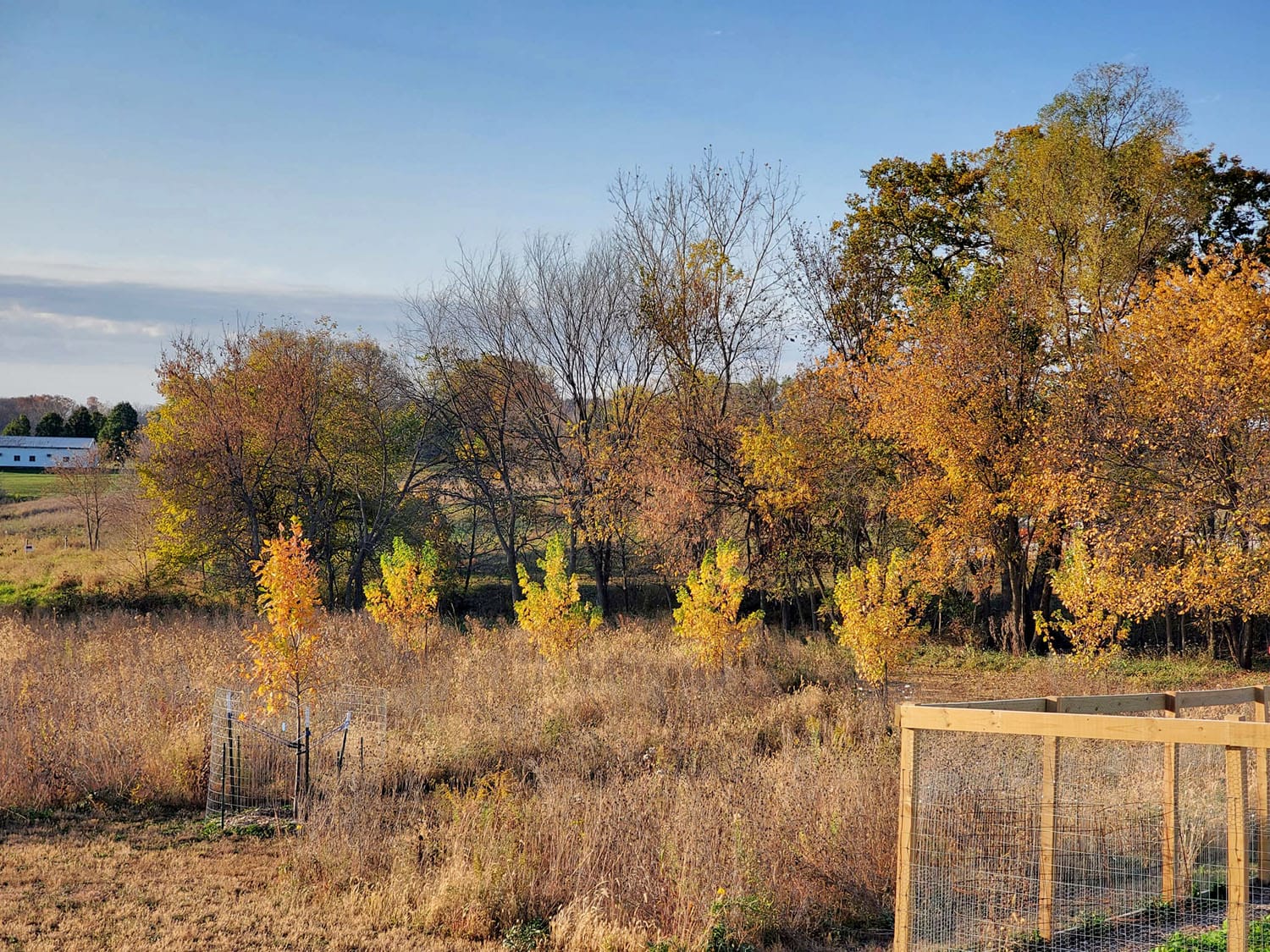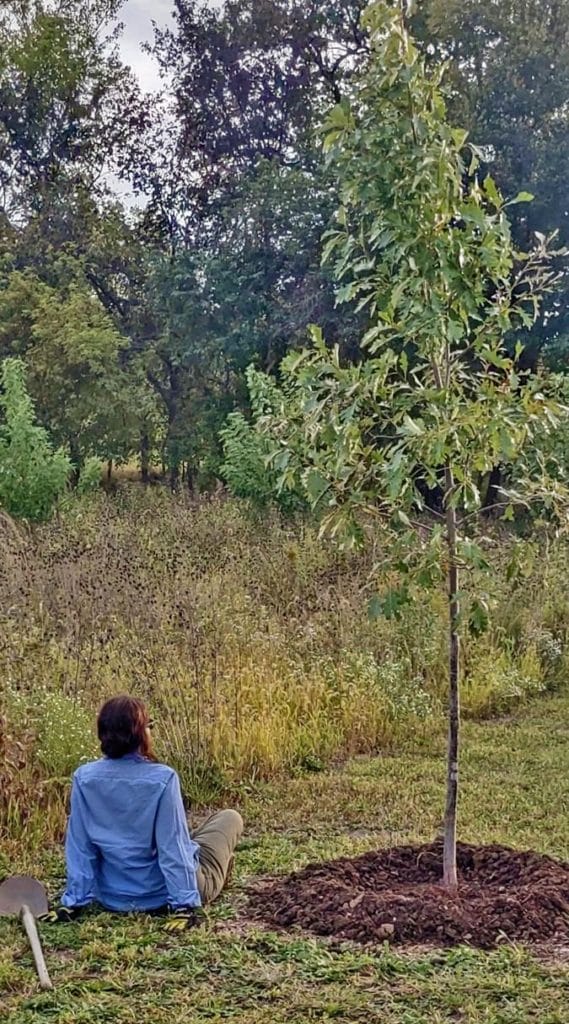The Wonders of Windbreaks
Since taking over managing her family land, Ruth Rabinowitz has planted hundreds of trees to benefit wildlife and the land
Ruth Rabinowitz is a farmer and landowner in Iowa and South Dakota with a 270-acre farm in South Dakota and various smaller acreages spread between four farms in Iowa.*
Both farms are traditional corn and soybean operations, though she’s currently transitioning about a dozen acres of her Iowa land to organic alfalfa. Ruth’s father pieced together the family acreage through the years, with Ruth stepping into the farm manager role in 2012.
Since taking over land management, Ruth has incorporated cover crops, ponds and buffers for quail and pollinators. She has also installed wildlife corridors, particularly by using trees as windbreaks. “This has been my family’s home and has since become mine,” Ruth says. “I wanted to protect that and provide a home to wildlife as well.”
Creating a Home for Trees
According to Iowa State University, windbreaks offer myriad benefits. The most intuitive is that they slow wind speeds by acting as a physical buffer.
In Iowa and other parts of the Midwest that tend to experience cold, snowy winters, tamping wind speed can lower home heating costs by as much as 30%. It can also limit snow drifts from building up against homes and outbuildings. These benefits were likely evident in Iowa this year, where heavy snowfall and blizzard conditions swept across the state in January.

Three-year-old silver maple trees growing amongst mature box elders, red oaks and hackberry on Ruth Rabinowitz’s farm.
But windbreaks, also referred to as shelterbelts, were first used in the U.S. in the 1930s to halt a different sort of blizzard: the tsunami of topsoil exposed by years of poor farming practices that swept across the Great Plains during the Dust Bowl years.
As part of his plan to help halt the ecological disaster, President Franklin Delano Roosevelt launched the Prairie States Forestry Project, which between 1935 and 1942 planted about 200 million trees across six states, according to the U.S. Forest Service.
Shelterbelts also benefit livestock in a range of ways. Livestock that can shelter within these areas have better feed efficiency and less weather-related stress.
In the winter, these areas can reduce wind chills, increasing the temperature within the windbreak and creating a more comfortable environment for the animals. For farmers, this can translate to cost savings since the animals will require less feed to maintain their core temperatures.
Ruth doesn’t have livestock but says she noticed other benefits of planting trees. “There was a definite energy savings. The trees, some now getting taller, are protecting my home and structures from the winds that often hit harder in the winter.”
“And,” she adds, “while this is my home for now, these trees will be here another 100 or 200 years. This is paying it forward to the next generation. These trees provide such a sense of beauty and serenity – and home.”’
Creating a Home for Trees
When Ruth first acquired the farm from her father, she put a lot of effort into conservation practices, particularly trees. Sourcing trees from the Iowa Department of Natural Resources and a local nursery, she planted 300 trees, many by hand – though she had help from contractors for some of the planting work.
Tree spacing was largely decided by local arborists, who based their decision on the expected height of each species. On average, however, trees in the windbreak are spaced about 20 feet apart. Ruth handles all the maintenance on her own, which includes mowing, mulching and fencing.

Ruth takes a break after planting a white oak on her farm. She planted most of her trees by hand and watered all with rain barrels.
“I had never done this before. It wasn’t like planting a single tree in a backyard,” she says. “This was a lot of digging one by one with an auger, planting, then putting in angle stakes and installing chicken wire as protection.”
Despite the extra labor involved, she opted for that approach because she’s not a fan of tree tubes. “Aside from the expense, they (tree tubes) always felt claustrophobic to me. These trees are like babies, and all they know is your soil. I wanted them to be at home here.”
Ruth planted the trees on the sides of her house where the prevailing winds came from and tended each tree by hand, monitoring them for signs of distress throughout three summers of drought.
She started out watering the trees by hand, but later added hydrants – something she now recommends for anyone planning to install large windbreaks. “I put in four hydrants, and now have water on all four sides of my house. It’s about making it easier and comfortable for myself.”
Easier water access translates to better long-term care – and Ruth’s hard work is evident.
“The trees are growing so well,” she says. “I couldn’t believe how well the silver maple is growing. They are putting out a remarkable show of color, and my red oaks, even for a slower-growing species, are growing well.” Ruth reports a survival rate over 85% for all her trees.
Looking back, however, she says there’s one species she would not plant again: hackberry. While the species is native to Iowa and rates highly for benefits such as providing wildlife habitat, for Ruth, other species have proven easier to care for.
“While they are growing well,” she says, ”the hackberries seem to need more water, mulch and care.” And on her land, Ruth has also observed that wildlife seem to favor other species like red oaks, silver maples, serviceberry and concolor fir.
“I really liked the idea of the concolor firs,” Ruth says. “I just knew that I wanted some evergreens because everything else drops their leaves in winter, and I wanted year-round wind protection and habitat.”
Trees for Stewardship
Her reflections on hackberry are part of broader concern for Ruth: creating a hospitable place for wildlife. “I really feel like this is their home too, not just mine. It goes back to the Indigenous way of thinking – of sharing the land and being a good steward.”
Beyond the cost- and energy-saving benefits, windbreaks play a critical role in providing home for wildlife. In Iowa, migratory birds, squirrels, deer and other mammals, as well as pollinating insects, can all find shelter, sustenance and safety in these areas. Ruth found that once she started planting trees, birds followed.
“When I first moved here, the bird song was dim,” she says. After planting trees, prairie and adding other conservation practices, she now says that “the birdsong surrounds the home. It’s like a theater or having a personal stereo of birdsong. I also have owls. They particularly love the oak trees. And we have resident pheasants and quail.”
In addition to birds, Ruth has encountered beneficial snakes on the farm, as well as moles, rabbits and raccoons. The trees, she says, are a scaffold for many species. “When you have trees, they have places to perch. They have places to get nesting material and leaves to hibernate under.”
“Yes, there’s crop ground here, but there are also ponds, prairie and trees. This is a haven for wildlife.”
*Please note the information regarding the number and location of the acres owned by Ruth was incorrect in the print version of the magazine.
